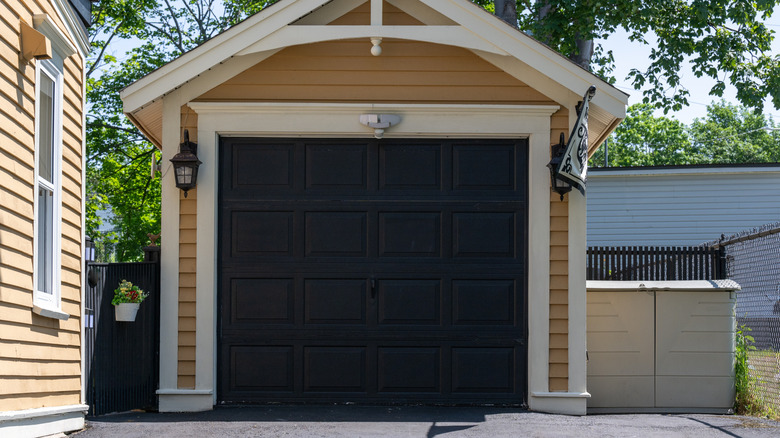Tackle Mildew On Your Garage Door With A Bathroom Cleaning Solution
We may receive a commission on purchases made from links.
If you've spotted dark streaks or patches forming around the weather stripping on your garage door, you're likely dealing with mildew. This is especially common in humid or rainy climates, and while it might seem harmless at first, mildew can slowly eat away at surfaces, stain the trim, and even trigger respiratory irritation if it spreads indoors. Fortunately, there's no need to invest in a pressure washer or mix up complicated solutions. Your answer might already be under the bathroom sink.
Enter: Scrubbing Bubbles Foaming Bleach Bathroom Cleaner. While it's typically used to tackle grime in tubs and tile, its bleach-based formula makes it surprisingly effective on mildew growing on exterior surfaces like your garage door. You may not think it'd work well for the weather stripping around your garage door, but the results are kind of magic. No scrubbing, no hose, and no pressure washer needed. Just a towel, a little patience, and a quick spray. Before starting, gather your supplies: Scrubbing Bubbles Foaming Bleach cleaner, an old towel to block overspray, gloves and mask for safety, and protective eyewear. Opening the garage door for airflow and protecting nearby surfaces ensures the bleach doesn't spread or damage other materials. It's a quick, budget-friendly fix that could save you from a bigger headache down the line. If you're trying to tidy up the rest of your garage space, here are 12 simple garage cleaning tips you don't want to skip this spring.
Remove mildew on your garage door with foaming bleach solution
Once your garage door is open and prepped, the actual cleaning part is refreshingly simple. With gloves on, spray the Scrubbing Bubbles cleaner directly onto the affected areas — especially around the weather stripping where mildew loves to hide. Place a towel or rag behind the surface as you spray to absorb any runoff. Then... just walk away. The foaming bleach solution clings to vertical surfaces, breaking down mildew stains on its own. No need for a scrub brush or rinse-off. Just let it sit and do the work. After about 10 to 15 minutes, check the area. In many cases, the mildew will have faded significantly or disappeared completely. If there's stubborn residue, a second application may help, or you can gently wipe it with a damp cloth. Either way, it's a low-effort, high-reward hack. That being said, bleach isn't always the solution and you should never use bleach to clean certain things.
If you want to take it a step further, you can add a mildew-resistant weather seal or apply a clear outdoor sealant to help prevent future buildup. You can even paint or touch up the trim for a cleaner, more polished look. This hack works so well because bleach is a mold and mildew killer for nonporous surfaces, and the foaming action allows it to cling to surfaces longer than traditional liquid cleaners. It's a repurposed product that's both effective and accessible, proving once again that sometimes the best home fixes come from unexpected places. As always, be extra careful when using cleaning supplies and follow these crucial precautions before cleaning your home with bleach.

